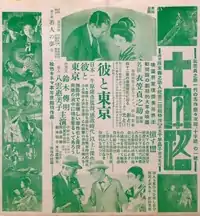Crossroads (1928 film)
Crossroads (十字路, Jūjiro), also known as Crossways, Shadows of the Yoshiwara or Slums of Tokyo, is a 1928 silent Japanese drama film directed by Teinosuke Kinugasa.[1][2][3] It is believed to be the first[4] or one of the first[5][6] Japanese films to be screened in Europe, and often mentioned in conjunction with Kinugasa's other avant-garde film, the two years earlier A Page of Madness.[4]
| Jūjiro | |
|---|---|
 Japanese movie poster | |
| Directed by | Teinosuke Kinugasa |
| Written by | Teinosuke Kinugasa |
| Starring |
|
| Cinematography | Kōhei Sugiyama |
Production companies |
|
| Distributed by | Shochiku |
Release date | |
Running time | 88 minutes[3] |
| Country | Japan |
| Language | Japanese (intertitles) |
Plot
A young man is obsessed with courtesan O-ume, but she refuses to meet him anymore, finding him too persistent. During a fight, the young man seemingly kills his rival, and is himself blinded. He hides in the flat which he shares with his sister, not knowing that the rival's death was only staged. A man approaches the sister, pretending to be a policeman who can help her to clear her brother from the charges with money. Also, a doctor whom the sister consults declares that her brother's eyes can be cured, but only if she can pay him. To collect the money, she offers herself as a prostitute to a procuress. When the alleged policeman attempts to rape the sister, she stabs him. Meanwhile, the brother has regained his eyesight on his own, goes to O-umes house and dies under her window, foaming from the mouth and ridiculed by O-ume and his rival. The last scene shows the sister standing at a crossway, calling in vain for her brother.
Cast
- Akiko Chihaya as the sister
- Toshinosuke Bando as the brother
- Yukiko Ogawa as O-ume, the courtesan
- Minoru Takase as the policeman (as Ippei Sōma)
- Misao Seki as the landlord
- Yoshie Nakagawa as the procuress
- Teruko Nijō as the wrong woman
- Keinosuke Sawada as the rival (as Myoichiro Ozawa)
Release history
Crossroads was released in Japan on 11 May 1928.[1][2] It was first screened in London on 26 January 1930 as Crossways[7] and shown in New York in July of the same year as Slums of Tokyo.[8] While favourably received by critics in Berlin and Paris,[4][9] the New York Times critic stated, the film "possesses the virtue of sincerity but its tempo is too heavy".[8] In later years, film historians repeatedly commented on the influence of the German expressionist film on Crossroads,[10][11] in particular the works of Fritz Lang.[5]
Legacy
Crossroads was screened at the Berkeley Art Museum and Pacific Film Archive in 1983,[12] at the International Film Festival Rotterdam in 2000,[13] at the San Francisco Silent Film Festival in 2008[14] and at the Berlin International Film Festival in 2014.[15] It was included in the British Film Institute's "The best Japanese film of every year – from 1925 to now" list.[4]
References
- "十字路 (Crossroads)". Japanese Movie Database (in Japanese). Retrieved 22 March 2021.
- "十字路 (Crossroads)". Kinema Junpo (in Japanese). Retrieved 22 March 2021.
- "十字路 (Crossroads)". National Film Archive of Japan (in Japanese). Retrieved 22 March 2021.
- "The Best Japanese Film of Every Year – From 1925 to Now". British Film Institute. Retrieved 3 January 2022.
- Richie, Donald (2005). A Hundred Years of Japanese Film (Revised ed.). Tokyo, New York, London: Kodansha International. pp. 89–90. ISBN 978-4-7700-2995-9.
- Jacoby, Alexander (2008). Critical Handbook of Japanese Film Directors: From the Silent Era to the Present Day. Berkeley: Stone Bridge Press. p. 114. ISBN 978-1-933330-53-2.
- Sharp, Jasper (2011). Historical Dictionary of Japanese Cinema. Lanham, Toronto, Plymouth: Scarecrow Press. p. 12. ISBN 978-0-8108-5795-7.
- "JAPANESE FILM IS SHOWN. "Slums of Tokyo," Silent Picture, Tells Tale of Utter Despair". The New York Times. 7 July 1930. Retrieved 22 March 2021.
- Anderson, Joseph L.; Richie, Donald (1959). The Japanese Film – Art and Industry. Charles E. Tuttle Company. pp. 55–57.
- Lloyd, Ann; Robinson, David, eds. (1984). Movies of the Silent Years. The University of Michigan. p. 200.
- Kuhn, Annette; Westwell, Guy, eds. (2012). A Dictionary of Film Studies. Oxford University Press. p. 240. ISBN 9780199587261.
- "Crossroads (Jujiro)". BAMPFA. Retrieved 25 July 2023.
- "Jujiro". IFFR. Retrieved 25 July 2023.
- "Jujiro". SFSFF. Retrieved 25 July 2023.
- "Jujiro". Berlinale.de. Retrieved 25 July 2023.
External links
- Crossroads at IMDb
- Gardner, William O. (Spring 2004). "New Perceptions: Kinugasa Teinosuke's Films and Japanese Modernism". Cinema Journal. University of Texas Press. 43 (3): 59–78. doi:10.1353/cj.2004.0017. S2CID 55444732. Retrieved 22 March 2021.